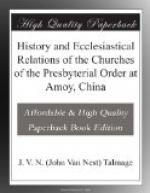It would have occupied too much space to have quoted the whole of the Report of the Committee. The preceding part of it occupies nearly six pages of the Minutes of Synod. Yet we may not pass that part over in silence, for, while with much of its contents we have no dispute, it contains some grave mistakes of fact, and, as we think, some very grave errors of doctrine. It grieves me to say thus much, and also to feel compelled to add the following strictures. But, in order to discuss this subject, duty required the careful examination of the whole of the Report, and, finding in it such errors, the clear statement of them. It might be easy, perhaps, to account for the fact, that mistakes, in a report, unprinted, and of such length, should escape the notice of Synod, but an attempt to apologize for that body might give occasion to infer more disrespect than simply to point out the mistakes.
After some introductory remarks, chiefly concerning the difficulty of their task, the Committee “begin with the assertion of principles.” These they make three in number. The sum of the first principle is that a Church, by divine arrangement, has government. The essential idea of their second principle, so far as we can understand it, is, that the Dutch Church has a clearly defined government. The Missionaries at Amoy, as well as the ministers in this country, admit both these principles fully. But they do not affect the question in dispute. Not so with the third principle of the Committee. Lest I might be supposed to misrepresent, I will quote their own language: “No government can, voluntarily, relinquish its powers, and abnegate its authority without thereby inviting disorder, disquietude, and, in the end, its destruction.” Is this, indeed, as the Committee assert, one of the “admitted principles” of our Church? one of the “convictions in the mind of our Church, hardly separable in idea from its very existence?” one of the “old




